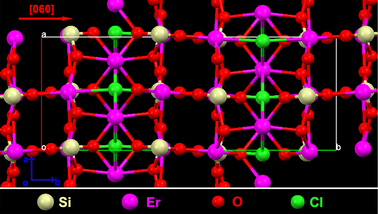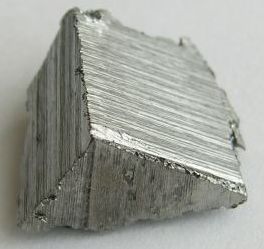Nov
23
Big Improvement to Erbium Doping Materials
November 23, 2011 | 1 Comment
Erbium isn’t likely on most folks news watch list, but the rare earth element is used more than we realize and a material doping improvement has significant potential across a wide set of fields.
Arizona State University researchers have created a new crystal material compound called erbium chloride silicate. Electrical engineering professor Cun-Zheng Ning at ASU says the material can be used to develop the next generations of computers, improve the capabilities of the Internet, increase the efficiency of silicon-based photovoltaic cells to convert sunlight into electrical energy, and enhance the quality of solid-state lighting and sensor technology.
To start, erbium is one of the most important members of the rare earth family in the periodic table of chemical elements. It emits photons in the wavelength range of 1.5 micrometers, which are used in the optical fibers essential to high-quality performance of the Internet and telephones. Thus, erbium is used in doping optical fibers to amplify the signals of Internet and telephone telecommunications systems.
Next, doping is the term used to describe the process of inserting low concentrations of various elements into other substances as a way to alter the electrical or optical properties of the substances to produce the desired results. The elements used in such processes are referred to as “dopants”.
The ASU breakthrough involves the first-ever synthesis of a new erbium compound in the form of a single-crystal nanowire, which has superior properties compared to erbium compounds in other forms. Details about the new compound are reported in the Optical Materials Express on the website of the Optical Society of America.
Professor Ning explains, “Since we could not dope as many erbium atoms in a fiber as we wish, fibers had to be very long to be useful for amplifying an Internet signal. This makes integrating Internet communications and computing on a chip very difficult.”
“With the new erbium compound, 1,000 times more erbium atoms are contained in the compound. This means many devices can be integrated into a chip-scale system,” he said. “Thus the new compound materials containing erbium can be integrated with silicon to combine computing and communication functionalities on the same inexpensive silicon platform to increase the speed of computing and Internet operation at the same time.”
The next major application field is solar cells where erbium materials can also be used to increase the energy-conversion efficiency. Silicon does not absorb solar radiation with wavelengths longer than 1.1 microns, leaving longer wavelengths unused — shorting solar cell efficiency.
Erbium materials can remedy the situation by converting two or more photons of longer wavelengths carrying small amounts of energy into one photon that is carrying a larger amount of energy. The single, more powerful photons can then be absorbed by silicon, thus increasing the efficiency of solar cells.
Part two in solar cells is erbium materials also help absorb ultraviolet light from the sun and convert it into photons carrying small amounts of energy, which can then be more efficiently converted into electricity by silicon cells.
The third industrial application is the color-conversion function of turning ultraviolet light into other visible colors of light that’s important in generating white light for solid-state lighting devices.
Here’s why this matters, as Ning explains further that erbium’s importance is well-recognized, producing erbium materials of high quality has been challenging. The standard approach is to introduce erbium as a dopant into various host materials, such as silicon oxide, silicon, and many other crystals and glasses.
Ning explains, “One big problem has been that we have not been able to introduce enough erbium atoms into crystals and glasses without degrading optical quality, because too many of these kinds of dopants would cluster, which lowers the optical quality.”
The Ning group solution is synthesizing a new erbium material such that the erbium is no longer randomly introduced as a dopant. Then the erbium is part of a uniform compound and the number of erbium atoms is a factor of 1,000 times more than the maximum amount that can be introduced in other erbium-doped materials.
The effect is the number of erbium atoms provides more optical activity to produce stronger lighting and enhances the conversion of different colors of light into white light to produce higher-quality solid-state lighting and enables solar cells to more efficiently convert sunlight in electrical energy.
Plus erbium atoms are organized in a periodic array, they do not cluster in this new compound, leading one to think that processing and application costs could be reduced.
The Ning group’s story has an interesting start – the synthesis of this new erbium material was made somewhat by accident, “Similar to what other researchers are doing, we were originally trying to dope erbium into silicon nanowires. But the characteristics demonstrated by the material surprised us,” he says. “We got a new material. We did not know what it was, and there was no published document that described it. It took us more than a year to finally realize we got a new single-crystal material no one else had produced.”
Ning and his team are now experimenting to use the new erbium compound for various applications, such as increasing silicon solar cell efficiency and making miniaturized optical amplifiers for chip-scale photonic systems for computers and high-speed Internet fiber and lasers.
“Most importantly,” he says, “there are many things we have yet to learn about what can be achieved with use of the material. Our preliminary studies of its characteristics show it has many amazing properties and superior optical quality. More exciting discoveries are waiting to be made.”
In the U.S. where Internet speeds are far slower than in some other parts of the world this news isn’t so remarkable. But data volume is growing fast and improved fiber is going to matter sooner than many realize. Then the solar cell industry still needs to gain technology to reduce costs further, there is a long way to go and if erbium doping pulls more energy for low cost process the improved harvest will help drive more adoption.
Erbium doping isn’t a big issue, but a major improvement in the science will have a big effect on some important big ones.
Comments
1 Comment so far




Meanwhile – the IOC has developed a simple blood test to diagnose Erbium Doping.